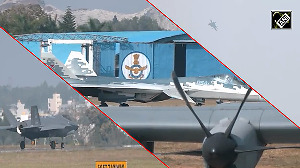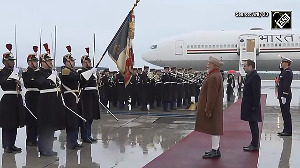It is no coincidence that within three days of the blast at Hyderabad Mecca Masjid, the Pakistan government decided to free the chief of Harkat-ul Jihad al Islami, the terrorist group that is accused of executing the attack to trigger communal disturbances in India.
Qari Saifullah Akhtar, the leader of the terrorist outfit and a known associate of Taliban chief Mullah Omar and Al Qaeda leader Osama bin Laden, was released by the ISI on Monday in Chakwal, a district near Rawalpindi. He was arrested in Dubai on August 6, 2004 and handed over to Pakistan.
Akhtar's sudden release is an indication of a possible move by the ISI to rehabilitate jihadi leaders who have been in the forefront of the Afghan jihad. Akhtar's rivals in the jihadi business, Maulana Masood Azhar of Jaish-e-Mohammad and Fazlur Rehman Khalil of Harkat-ul Mujahideen, have been released earlier. All three are associated with Mullah Omar and Osama bin Laden.
Projected as the second line of defence of the Islamic cause, the group is closely linked to the Jamiat-e-Ulema e-Islam-Fazlur Rehman, a key religious party which is an ally of the Musharraf regime. The group, which once operated from Bosnia, Sinkiang and Myanmar, is today confined to Pakistan and Bangladesh, and is a key element in the ISI's plan to regroup terrorist operations in India.
This regrouping will have a far-reaching impact on India as all three groups are now programmed to launch terror attacks not only in Kashmir but across the country.
The coming together of different terrorist groups like the Lashkar-e-Tayiba, Jaish-e-Mohammed and the HuJI has been quite visible since the serial blasts in Delhi on October 29, 2005.
The subsequent Bangalore attack of December 2005, the March 2006 Varanasi blasts, the July 2006 Mumbai serial blasts and the Hyderabad blast of last week have clearly revealed the emerging contours of a new terrorist plan put together in Islamabad. And the HuJI is a critical cog in this wheel.
This terror matrix comprises three major terrorist groups, at least half-a-dozen big and small front organisations with extremist ideology, spanning three countries; several layers of support bases; an extensive network of hawala channels running from the Middle East to Indonesia; a weapons route, a communications network linking hideouts in Kashmir, Pakistan, Bangladesh and Nepal.
It is quite obvious that neither the Lashkar nor the HuJI, independently or jointly, are capable of planning such a confederation or enabling an extraordinarily multi-layered logistic network to support its mission objectives. In this case, it is clear that the Inter Services Intelligence, working on this strategy since the early 1990s, has managed to bring together terrorist and extremist groups with different ideologies for a common cause.
There are other aspects to this new strategy which merits closer attention. The recent terrorist incidents establish the intention of terror masterminds to establish Islamist terrorist network beyond Kashmir, a strategic move considering the international focus and the dialogue.
Another integral part of this strategy is the use of local recruits and explosives to create bombs, as seen in Varanasi, Delhi, Malegaon, Mumbai, the Samjhauta Express and Hyderabad blasts.
Of greater concern is the agenda behind this new strategic alliance. These terrorist attacks were aimed at creating communal backlash and deepen the divide between two communities. HuJI chief Akhtar's release will only make matters worse for India while giving Pakistan the benefit of deniability since HuJI operates largely from Bangladesh.






 © 2025
© 2025